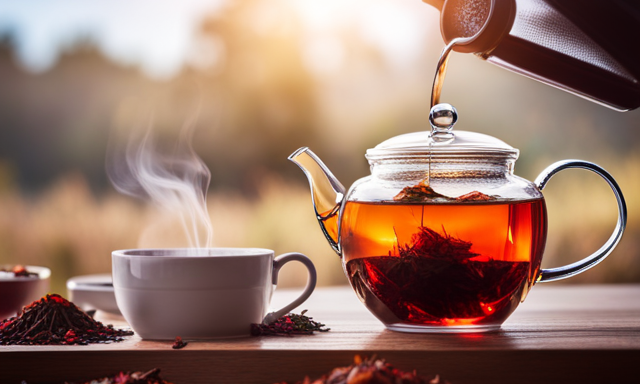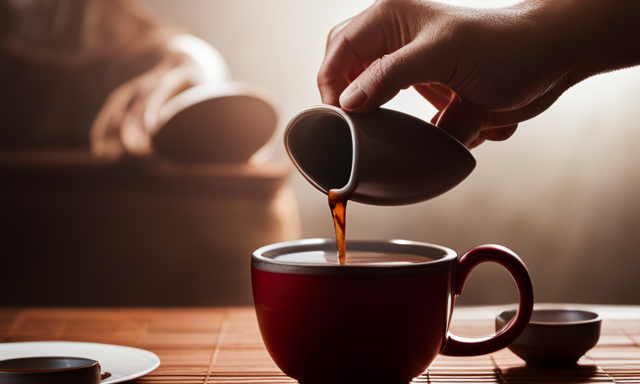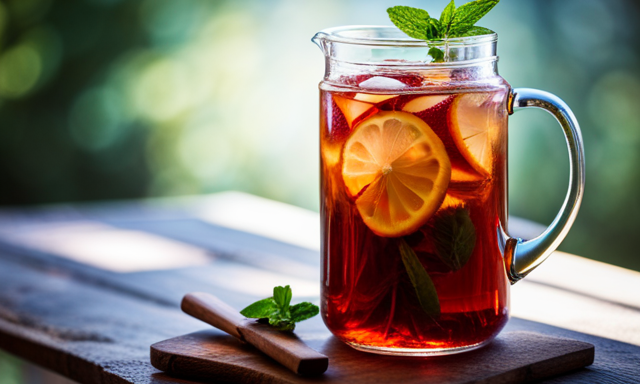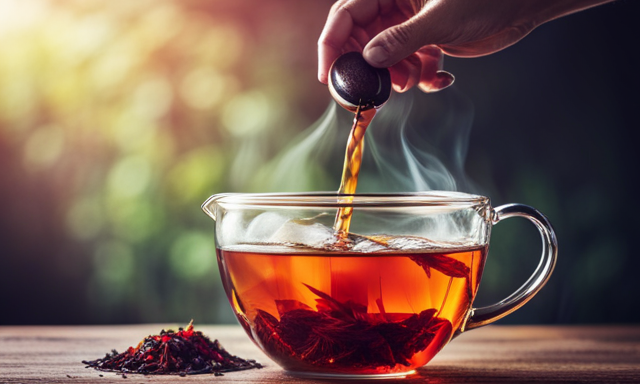As I sit down to enjoy a warm cup of loose leaf rooibos tea, I can’t help but think about the soothing and comforting qualities this beverage embodies. Like a gentle hug for the soul, rooibos tea has the power to transport you to a place of tranquility and relaxation. With its vibrant red color and earthy flavor, it’s no wonder that rooibos tea has become a beloved drink around the world.
In this article, I will guide you through the process of brewing the perfect cup of loose leaf rooibos tea. From selecting the right tea leaves to steeping them just long enough to extract the full flavors, I will share with you my knowledge and expertise on this delightful beverage.
Whether you’re a seasoned tea enthusiast or new to the world of loose leaf tea, this step-by-step guide will ensure that you can enjoy a cup of rooibos tea that is truly a work of art.
So, grab your favorite mug and let’s embark on this flavorful journey together.
Key Takeaways
- Enhance the flavors of rooibos tea by using herbs like mint or lavender
- Experiment with different brewing methods to discover your preferred taste
- Let the tea steep for a longer period of time to develop flavors
- Serve rooibos tea hot and try adding lemon or honey for a twist
Introduction to Rooibos Tea
Rooibos tea, with its rich amber color and earthy aroma, is like a warm hug for your senses. This tea has a fascinating history that dates back centuries. Originating from South Africa, rooibos tea was first discovered by the indigenous Khoi-San people. They believed in its healing properties and used it as a traditional remedy for various ailments.
Today, there are two main types of rooibos tea: green rooibos and fermented rooibos. Green rooibos is unfermented and offers a lighter, more delicate flavor profile, while fermented rooibos has a deeper, sweeter taste. Both types are caffeine-free and packed with antioxidants, making them a popular choice for those seeking a healthier alternative to traditional tea.
Now, let’s delve into the next section to understand the numerous health benefits of rooibos tea.
Understanding the Health Benefits of Rooibos Tea
Indulging in a cup of this magical herbal infusion can leave you feeling rejuvenated and full of vitality. Understanding the origins of rooibos tea is essential to truly appreciate its health benefits.
This unique tea is native to the Cederberg region of South Africa, where it has been consumed for centuries due to its numerous health benefits. Rooibos tea is naturally caffeine-free and packed with antioxidants, making it a perfect choice for those looking for a soothing and healthy beverage.
Exploring the different varieties of rooibos tea is an exciting journey. The most common type is red rooibos, which has a rich and earthy flavor. Green rooibos, on the other hand, offers a lighter and more grassy taste. For those who prefer a touch of sweetness, there are also flavored rooibos teas available, such as vanilla or berry-infused options.
Transitioning into the subsequent section about choosing the right loose leaf rooibos tea, it is important to consider factors such as quality, freshness, and personal preferences.
Choosing the Right Loose Leaf Rooibos Tea
When it comes to selecting the perfect cup of rooibos, you’ll want to consider factors like your personal taste preferences, the quality of the tea, and its freshness, in order to ensure a delightful and invigorating experience. Remember, the right cup of tea can truly make your day!
| Loose Leaf Rooibos Tea Types | Benefits of Loose Leaf Tea |
|---|---|
| Green Rooibos | Rich in antioxidants, supports immune system |
| Red Rooibos | Promotes digestion, aids in relaxation |
| Honeybush Rooibos | Helps with skin health, reduces inflammation |
| Vanilla Rooibos | Enhances mood, relieves stress |
| Rooibos Chai | Boosts metabolism, aids in weight loss |
When choosing loose leaf rooibos tea, you have a variety of options to explore. Green rooibos is known for its antioxidant properties and immune system support. Red rooibos aids in digestion and promotes relaxation. Honeybush rooibos helps with skin health and reduces inflammation. Vanilla rooibos enhances mood and relieves stress. And rooibos chai boosts metabolism and aids in weight loss. So, take your pick and get ready to enjoy the numerous benefits of loose leaf tea. Now, let’s move on to preparing your tea infuser and tea kettle.
Preparing Your Tea Infuser and Tea Kettle
To prepare your tea infuser and tea kettle, all you need to do is gather your favorite loose leaf blend, a cozy cup, and some boiling water.
First, make sure your tea infuser is clean and free from any previous residue. Regular maintenance is important to ensure the longevity of your infuser and to prevent any unwanted flavors from seeping into your tea.
Next, choose the right type of tea kettle for your brewing needs. There are various options available, such as stovetop kettles, electric kettles, or even glass kettles with built-in infusers. Consider factors like speed, convenience, and personal preference when selecting the perfect kettle.
Now that your tea infuser and kettle are ready, let’s move on to measuring the perfect amount of loose leaf rooibos tea for a delightful brew.
Measuring the Perfect Amount of Loose Leaf Rooibos Tea
Get ready to experience the perfect cup of rooibos tea by measuring just the right amount of your favorite blend. When it comes to loose leaf rooibos tea, measuring techniques are crucial to ensure a balanced and flavorful brew.
Start by using a teaspoon to measure one teaspoon of loose leaf tea per cup of water. This measurement provides the ideal strength for a rich and aromatic infusion. Remember, loose leaf tea expands as it steeps, so be sure to leave enough room for the leaves to unfurl and release their flavors.
Once you have measured the perfect amount of tea, it’s time to move on to the next step: boiling the water to the ideal temperature.
Boiling the Water to the Ideal Temperature
Once you’ve got the perfect amount of rooibos tea measured, it’s time to let the water reach its boiling point, like a kettle singing its melodic tune.
The ideal water temperature for brewing loose leaf rooibos tea is around 200°F (93°C). This temperature allows for the full extraction of flavors without scalding the delicate leaves.
There are a few boiling methods you can use to achieve this temperature. One option is to bring the water to a rolling boil and then let it cool for a minute or two before pouring it over the tea leaves. Another method is to heat the water until it starts to bubble gently and then remove it from the heat. Both methods ensure the water is hot enough to extract the rich flavors of the rooibos tea.
Now that the water is ready, it’s time to steep and infuse the rooibos tea, allowing its natural goodness to unfold.
Steeping and Infusing the Rooibos Tea
Experience the delightful transformation as the aromatic flavors of this exquisite beverage infuse your senses, creating a soothing and rejuvenating moment just for you.
To achieve the perfect cup of loose leaf rooibos tea, it is crucial to master the art of steeping. Follow these brewing techniques for a truly remarkable tea-drinking experience:
- Use a tea infuser or a strainer to hold the loose leaf rooibos tea.
- Bring fresh water to a rolling boil, then let it cool for a minute or two.
- Pour the hot water over the tea leaves, filling the cup or teapot.
- Allow the tea to steep for 5 to 7 minutes to extract its full flavor.
The steeping time may vary depending on your preference, but be cautious not to oversteep, as it can result in a bitter taste.
Now, let’s move on to the next step – adding sweeteners or flavors (optional).
Adding Sweeteners or Flavors (Optional)
Enhance your cup of this exquisite beverage with a touch of sweetness or a burst of flavor, if you dare to tread the path of indulgence. When it comes to sweetener options, you have a variety to choose from. Traditional choices like honey or sugar can add a delightful sweetness to your rooibos tea. For a healthier alternative, try using stevia or agave nectar. If you’re feeling adventurous, you can experiment with flavoring techniques. Adding a slice of lemon or a few drops of vanilla extract can elevate the taste profile of your tea. Another option is to infuse your tea with herbs like mint or lavender for a refreshing twist. Remember, the key is to enhance the natural flavors of rooibos without overpowering them. As you explore these options, you’ll discover your personal preference and create a unique cup of rooibos tea that suits your taste buds perfectly. Now, let’s move on to pouring and enjoying your cup of rooibos tea, where you can savor the fruits of your labor.
Pouring and Enjoying Your Cup of Rooibos Tea
Savor the moment as you pour and indulge in the exquisite flavors of your perfectly brewed cup of rooibos tea.
The aroma that wafts through the air is simply delightful, teasing your senses and preparing you for the experience ahead.
As you take your first sip, you can taste the natural sweetness and earthy undertones of the tea. It’s a comforting and calming sensation that instantly relaxes you.
You may find yourself wanting to experiment with different brewing methods to further enhance the flavors of your rooibos tea. Whether you prefer a longer steeping time or a higher water temperature, each variation can bring out unique qualities in the tea.
As you explore and discover your preferred method, you’ll unlock a world of possibilities for enjoying this wonderful beverage.
Now, let’s move on to some tips and tricks for brewing the best rooibos tea.
Tips and Tricks for Brewing the Best Rooibos Tea
When it comes to brewing the best cup of rooibos tea, one secret is to let the tea steep for a longer period of time, allowing the flavors to develop and unfold like a blooming flower.
Rooibos tea is naturally caffeine-free and has a smooth, slightly sweet taste with hints of earthiness. To achieve the perfect brew, I recommend steeping the loose leaf rooibos tea in freshly boiled water for at least 5-7 minutes. This will ensure that the flavors are fully extracted and the tea is at its most flavorful.
After steeping, strain the tea leaves and serve it hot. For a twist, you can also try adding a slice of lemon or a drizzle of honey to enhance the taste. Rooibos tea is versatile and can be enjoyed plain or with a splash of milk.
Experiment with different brewing times and serving suggestions to find your perfect cup of rooibos tea.
Frequently Asked Questions
How long does loose leaf rooibos tea stay fresh?
The shelf life of loose leaf rooibos tea depends on storage methods. To keep it fresh, store it in an airtight container in a cool, dry place away from sunlight. Properly stored, it can stay fresh for up to two years.
Can I reuse the loose leaf rooibos tea leaves for a second brew?
Yes, you can reuse loose leaf rooibos tea for a second brew. Not only does it save money, but the flavor is often more nuanced and delicate. It’s like getting a bonus cup of tea!
Is loose leaf rooibos tea naturally caffeine-free?
Yes, loose leaf rooibos tea is naturally caffeine-free. It is a great alternative to caffeinated teas. In addition to its delicious flavor, it offers many health benefits, such as antioxidants and potential immune-boosting properties.
Can I drink loose leaf rooibos tea while pregnant or breastfeeding?
During pregnancy, it’s important to be cautious about what we consume. While some herbal teas are safe, it’s best to avoid loose leaf rooibos tea while pregnant. However, when breastfeeding, drinking tea can provide hydration and potentially offer some benefits.
How can I store my loose leaf rooibos tea to maintain its flavor and quality?
To properly store loose leaf rooibos tea and preserve its flavors, I recommend keeping it in an airtight container away from light, heat, and moisture. This will help maintain the tea’s freshness and quality.
Conclusion
Brewing loose leaf rooibos tea is a simple process that can be mastered with a few easy steps. Here’s how to do it:
-
Start by heating water to the appropriate temperature. Rooibos tea is best brewed with water that is just below boiling, around 200°F (93°C). Boiling water can sometimes make the tea taste bitter, so it’s important to keep the temperature in check.
-
Measure out the desired amount of loose leaf rooibos tea. As a general guideline, use one teaspoon of tea per cup of water. Adjust the amount according to your personal preference for a stronger or milder flavor.
-
Place the loose leaf tea in a tea infuser or a teapot with a built-in strainer. This will prevent the tea leaves from floating freely in your cup and make cleanup easier.
-
Pour the hot water over the tea leaves and let it steep for about 5-7 minutes. This will allow the flavors to fully develop and infuse into the water. If you prefer a stronger taste, you can steep it for a few minutes longer.
-
Once the tea has steeped to your liking, remove the infuser or strain the tea into your cup. This will prevent the tea from becoming too strong or bitter if left in contact with the leaves.
-
Enjoy your cup of freshly brewed rooibos tea as is, or add a touch of honey, lemon, or milk to enhance the flavor. Rooibos tea is naturally sweet and does not require any additional sweeteners, but feel free to experiment and find your perfect combination.
-
Take a moment to savor the aroma and flavors of the tea as you relax and unwind. Rooibos tea is known for its calming properties and can be enjoyed at any time of the day.
So, grab your favorite mug, follow these simple steps, and indulge in the delightful experience of brewing and sipping on a cup of loose leaf rooibos tea. Cheers to your newfound tea brewing skills and the moments of tranquility they bring!










